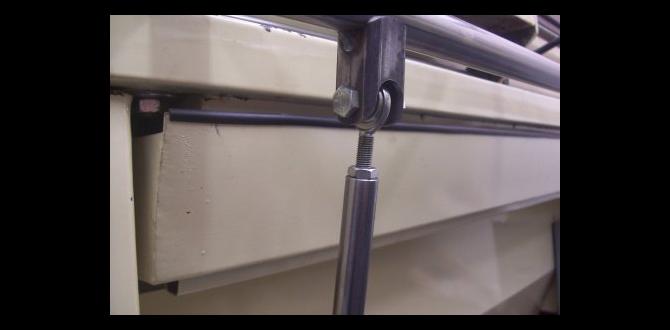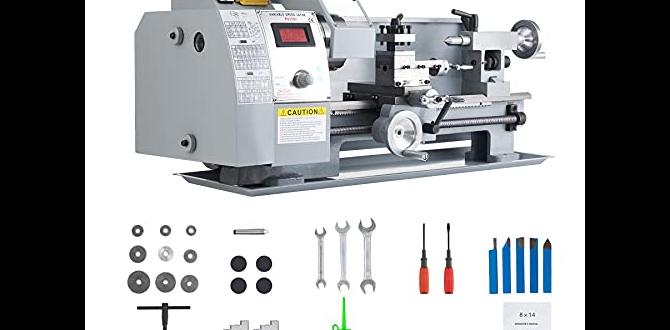A 1/8-inch carbide end mill is an excellent choice for cutting polycarbonate. Its sharp, durable edges slice cleanly through plastic without melting or chipping, providing precise results for a variety of projects.
Polycarbonate is a fantastic material. It’s tough, clear, and can be shaped into almost anything for your workshop or home projects. But cutting it cleanly can sometimes feel like a puzzle. Many beginners run into problems with melted plastic clinging to their tools or brittle edges chipping away. It’s frustrating when you’re aiming for that perfect finish. Don’t worry, though! There’s a simple, effective solution that’s often overlooked: using the right tool. In this guide, we’ll explore why a specific type of cutting tool, the 1/8-inch carbide end mill, is a real game-changer for working with polycarbonate. Get ready to achieve smooth, precise cuts every time.
Why a 1/8-Inch Carbide End Mill is Your Polycarbonate Pal
When you’re just starting out in machining, or even if you’re a seasoned hobbyist exploring new materials, choosing the right cutting tool can make all the difference. Polycarbonate, with its unique properties, presents a bit of a challenge. It’s strong, almost unbreakable, but also prone to melting when friction builds up. This is where a standard end mill might struggle, leading to gummy, messy results.
A 1/8-inch carbide end mill, however, is a different story. Let’s break down why it’s such a great fit for this versatile plastic.
Understanding End Mills: What They Are and How They Work
Before we dive into the specifics of polycarbonate, let’s quickly touch on what an end mill is. Think of it as a rotary cutting tool. Unlike a drill bit, which is designed to plunge straight down into material, an end mill has cutting edges on its sides as well as its tip. This allows it to cut horizontally into a workpiece, as well as down. They’re used in milling machines and CNC routers to create slots, pockets, profiles, and even 3D shapes.
End mills come in a huge variety of sizes, shapes, and materials. The size (like 1/8 inch) refers to the diameter of the cutting end. The material they are made from is crucial for performance.
Carbide: The Secret Ingredient
Most common end mills are made from High-Speed Steel (HSS). HSS is good, affordable, and can handle a lot of general-purpose cutting. However, when it comes to materials that can melt or are very hard, carbide shines.
Carbide, specifically tungsten carbide, is an incredibly hard and wear-resistant material. This means:
It stays sharper, longer: Less frequent tool changes and more consistent cuts.
It can handle higher speeds and feeds: You can often cut faster without damaging the tool or the workpiece.
It generates less heat during cutting: This is key for plastics like polycarbonate, as it helps prevent melting.
For polycarbonate, the superior hardness and heat resistance of carbide are precisely what you need. It can slice through the plastic cleanly, chip away small, manageable chips, and resist getting clogged with melted material.
Why 1/8 Inch? The Sweet Spot Size
The 1/8-inch (approximately 3.175mm) shank diameter is a popular size for a few reasons, especially when working on smaller projects or with less powerful machines:
Precision: Smaller diameter end mills allow for finer detail work. You can create tight corners and intricate patterns with ease.
Machine Compatibility: Many hobbyist CNC machines, desktop milling machines, and even some drill presses (when used in a milling setup) excel with smaller shank tools. They require less clamping force and put less stress on the machine components.
Material Removal Rate: While not for hogging out large amounts of material quickly, a 1/8-inch end mill is perfect for profiling, pocketing, and engraving polycarbonate where controlled material removal is more important than speed.
Cost-Effective: Generally, smaller end mills are less expensive than their larger counterparts.
The combination of carbide’s properties and the versatile 1/8-inch size makes a carbide end mill a “genius” tool for polycarbonate. It offers a fantastic balance of precision, durability, and clean cutting performance for a wide range of hobby and DIY projects.
Choosing Your 1/8-Inch Carbide End Mill for Polycarbonate
Not all 1/8-inch carbide end mills are created equal, especially when you’re targeting a specific material like polycarbonate. Here’s what to look for to ensure you get the best performance and longevity from your tool.
Key Features to Consider
When selecting your carbide end mill, pay attention to these specifications:
Number of Flutes: This refers to the number of cutting edges.
2 Flutes: Generally preferred for plastics and softer materials like aluminum. The extra space between the flutes (gullets) provides better chip evacuation, which is crucial for preventing melting in polycarbonate.
3 or 4 Flutes: Better for harder metals, offering a smoother finish and a higher material removal rate, but can sometimes cause melting issues in plastics due to reduced chip clearance. For polycarbonate, 2-flute end mills are usually the best bet.
Coating: Some end mills come with special coatings.
Uncoated: Perfectly fine for polycarbonate, especially if it’s a good quality carbide.
TiN (Titanium Nitride) or TiCN (Titanium Carbonitride): These coatings add a bit of hardness and reduce friction, which can be beneficial for plastics. They can improve tool life but aren’t strictly necessary.
ZrN (Zirconium Nitride): Often marketed for aluminum and plastics, ZrN coatings can provide excellent lubricity and reduce adhesion, leading to cleaner cuts and less melting.
Helix Angle: This is the angle of the flutes.
Standard Helix (often around 30 degrees): A good all-around choice.
High Helix (45 degrees or more): Provides a sharper cutting action and better chip evacuation, which is again beneficial for plastics.
End Type:
Square End: The most common type. Great for milling pockets and slots.
Ball End: The tip is a perfect hemisphere. Ideal for creating rounded edges, 3D surfacing, and engraving.
Corner Radius: A square end mill with a slight radius on the corners. This adds strength to the corners and can help prevent chipping in both the tool and the workpiece.
Material of the End Mill: Ensure it’s solid carbide. Some tools are carbide-tipped HSS, which is not the same for high-performance cutting in plastics.
Recommended Specifications for Polycarbonate
For a 1/8-inch carbide end mill used on polycarbonate, Daniel Bates at Lathe Hub highly recommends:
Type: Solid Carbide
Flutes: 2
Coating: Uncoated or ZrN (Zirconium Nitride) for optimal performance
Helix Angle: Standard or High Helix (30-45 degrees)
End Type: Square or Ball End, depending on your project needs. A small corner radius (e.g., 0.010″ or 0.25mm) on a square end can add durability.
Shank Diameter: 1/8 inch (3.175mm)
Length: Standard length is usually fine for most hobby projects. Extended length tools can sometimes be less rigid and may require slower feed rates.
Where to Find Quality End Mills
You can find quality 1/8-inch carbide end mills from several reputable sources:
Specialty Machining Tool Suppliers: Companies like Lakeshore Carbide, Lakeshore Tool, and USA Knifemakers often carry a good selection.
Major Tool Brands: Companies like YG-1, Sandvik Coromant (though often more industrial), and Fraisa offer high-quality options, though sometimes at a higher price point.
Online Retailers: Amazon, eBay, and specialized hobby machining sites often have a wide range of options from various manufacturers. Always check reviews and seller reputation when buying online. Look for detailed specifications.
Investing in a good quality 1/8-inch carbide end mill will pay dividends in the quality of your cuts and the longevity of your tool.
Setting Up Your Machine for Cutting Polycarbonate
Getting the right tool is only half the battle. Properly setting up your milling machine or CNC router is crucial for clean, safe polycarbonate cutting. Here’s how to prepare your workspace and machine for success.
Essential Tools and Safety Gear
Before you even power up your machine, ensure you have the right equipment and safety measures in place.
Safety Glasses/Face Shield: Always protect your eyes. Plastic chips can fly.
Hearing Protection: Milling can be noisy.
Dust Mask or Respirator: While polycarbonate doesn’t produce toxic fumes when cut correctly, fine plastic dust can be an irritant.
Clamps and Hold-Downs: Secure your polycarbonate workpiece firmly to the machine bed.
Compressed Air or Vacuum System: To clear chips and keep the cutting area clean.
Your 1/8-Inch Carbide End Mill: The star of the show!
Collet and Collet Wrench: To hold the end mill securely in your machine’s spindle. A precise collet is important for accurate runout.
Workholding Fixture (if needed): Depending on your project, you might need a custom jig or fixture.
Workholding: Keeping it Secure
Polycarbonate can be prone to vibration. If your workpiece isn’t held down firmly, it can chatter, leading to poor cut quality and potentially dangerous situations.
Use plenty of clamps: Distribute clamps evenly around the perimeter of your polycarbonate sheet. Don’t clamp directly on the area you’re about to cut, if possible.
Consider double-sided tape or specialized tape: For thinner sheets, strong double-sided tape can sometimes be used in conjunction with clamps.
Use a spoilboard: If you’re using a CNC, a sacrificial spoilboard (like MDF or plywood) underneath your polycarbonate can provide a stable, flat surface and protect your machine bed from accidental cuts.
Machine Settings: Speed and Feed Rate – The Magic Numbers
This is where many beginners struggle. Setting the correct spindle speed (RPM) and feed rate (how fast the tool moves through the material) is critical for polycarbonate. Too fast a feed rate or too slow a spindle speed can cause melting. Too slow a feed rate can lead to chip recutting and a poor finish.
This is a general guideline, and you’ll often need to adjust based on your specific machine, the exact type of polycarbonate, and the thickness of the cut. The table below offers a starting point.
Starting Speeds and Feeds for 1/8″ Carbide End Mill on Polycarbonate
| Parameter | Recommended Value (Typical) | Notes |
| :—————– | :————————– | :———————————————————————————————————————– |
| Spindle Speed (RPM) | 10,000 – 18,000 RPM | Higher RPMs are generally better for plastics as they help “slice” rather than “rub.” |
| Feed Rate (IPM) | 15 – 30 IPM | Start on the lower end. This is the rate your machine moves horizontally. |
| Plunge Rate (IPM) | 5 – 10 IPM | The speed at which the tool moves vertically into the material. Always use a slower plunge rate than the feed rate. |
| Depth of Cut (DOC) | 0.010″ – 0.060″ | For shallow passes. Avoid taking full depth cuts, especially on thicker material. Start shallow and take multiple passes.|
| Stepover | 30% – 50% | The amount the tool moves sideways between passes for pocketing or contouring. |
Important Considerations for Speeds and Feeds:
Chip Evacuation is Key: Polycarbonate needs to be able to clear its chips easily. If chips build up and get re-cut, they’ll melt and create a gummy mess.
Use Air Blast: A sharp blast of compressed air directed at the cutting tool will help clear chips and cool the cutting zone.
Check for Melting: If you see melting, stop immediately.
Increase feed rate: This helps the tool cut material rather than rub.
Increase spindle speed: This makes the cutter rotate faster, achieving a higher surface speed to slice more effectively.
Reduce depth of cut: Take shallower passes.
Improve chip evacuation: Use more air!
Use a Feed Rate Calculator: Many online feed rate calculators can help you get a more precise starting point, but always test. Sites like CNCCookbook offer valuable resources for calculating these numbers.
Toolpath Strategy
How you program your cuts (the toolpath) also matters.
Climb Milling vs. Conventional Milling: For plastics, climb milling is often preferred. In climb milling, the cutter rotates in the same direction as it moves into the material. This results in a thinner chip being taken, less friction, and a cleaner cut. Conventional milling, where the cutter rotates against the direction of movement, can push the material away and increase friction.
Multiple Shallow Passes: Instead of trying to cut through a thick piece of polycarbonate in one go, take multiple shallow passes. This reduces the load on the tool and machine, dissipates heat more effectively, and results in a much cleaner edge.
By carefully setting up your machine and employing smart cutting strategies, you’ll set yourself up for success when cutting polycarbonate with your 1/8-inch carbide end mill.
Step-by-Step Guide: Cutting Polycarbonate with Your 1/8″ Carbide End Mill
Now that you’ve got your tool, your machine is set up, and you understand the key principles, let’s get cutting! This step-by-step guide will walk you through the process.
1. Prepare Your Project File
Design Your Cut: Use your CAD (Computer-Aided Design) software to create the shape you need. This could be a simple circle, a complex profile, or a pocket.
Define Toolpath: In your CAM (Computer-Aided Manufacturing) software, select your 1/8-inch carbide end mill as the cutting tool. Define the cutting operations (e.g., contour, pocket, drill).
Set Parameters: Input the recommended speeds and feeds we discussed earlier. Ensure your depth of cut and stepover settings are appropriate for shallow passes. Double-check your origin point and cut depths.
Simulate: Always run a simulation of your toolpath in the CAM software. This allows you to catch potential errors, collisions, or unexpected movements before they happen on the machine.
2. Secure Your Workpiece
Mount the Polycarbonate: Place your polycarbonate sheet on your machine bed or spoilboard.
Clamp Firmly: Use your clamps, double-sided tape, or workholding fixtures to secure the material. Ensure it cannot move or vibrate during the cut. Pay attention to areas around your intended cut path.
3. Set Up the Machine and Tool
Install the End Mill: Insert the 1/8-inch carbide end mill into the collet, ensuring it’s seated correctly.
Tighten the Collet: Use the appropriate collet wrench to tighten the collet securely in the spindle.
Zero the Axes: Carefully jog your machine to the desired starting point (X, Y, and Z zero). This is often the edge of the material for profiling.
Set Z-Height: This is crucial. You can use a touch-off plate or carefully probe the surface of the polycarbonate to set your Z-zero. Make sure it’s accurate to avoid cutting too deep or not deep enough. Your CAM software will use this Z-zero to calculate cut depths.
4. Initiate the Cut with Safety First!
Put on Safety Gear: Safety glasses are non-negotiable. Hearing protection and a dust mask are also recommended.
Turn on Air Blast/Vacuum (if used): Ensure your chip evacuation system is running.
Start the Spindle: With the spindle at your programmed RPM, slowly lower the end mill towards the material.
Begin the Feed: Engage the feed rate. Let the machine move the tool through the first shallow pass.
5. Monitor the Cut and Adjust if Necessary
Watch and Listen: Pay close attention. You should hear a clean slicing sound, not a grinding or melting noise.
Look for Melting: If you see the plastic starting to melt and gum up the tool or the workpiece, stop the job immediately.
Troubleshooting on the Fly:
If Melting:
Try increasing the feed rate slightly.
Consider reducing the depth of cut further.
Ensure your air blast is strong and properly directed.
If Chattering/Vibration:
Ensure workpiece is clamped more securely.
Reduce feed rate or depth of cut.
Check for tool runout or a dull tool.
Multiple Passes: Allow the machine to complete all programmed shallow passes. Avoid taking a single, deep cut.
6. Finish the Job
Retract the Tool: Once the final pass is complete, the machine will automatically retract the tool.
Turn off Spindle and Air: Once the tool is clear of the material, turn off the spindle and air blast.
Inspect the Cut: Carefully remove the workpiece from the machine.






